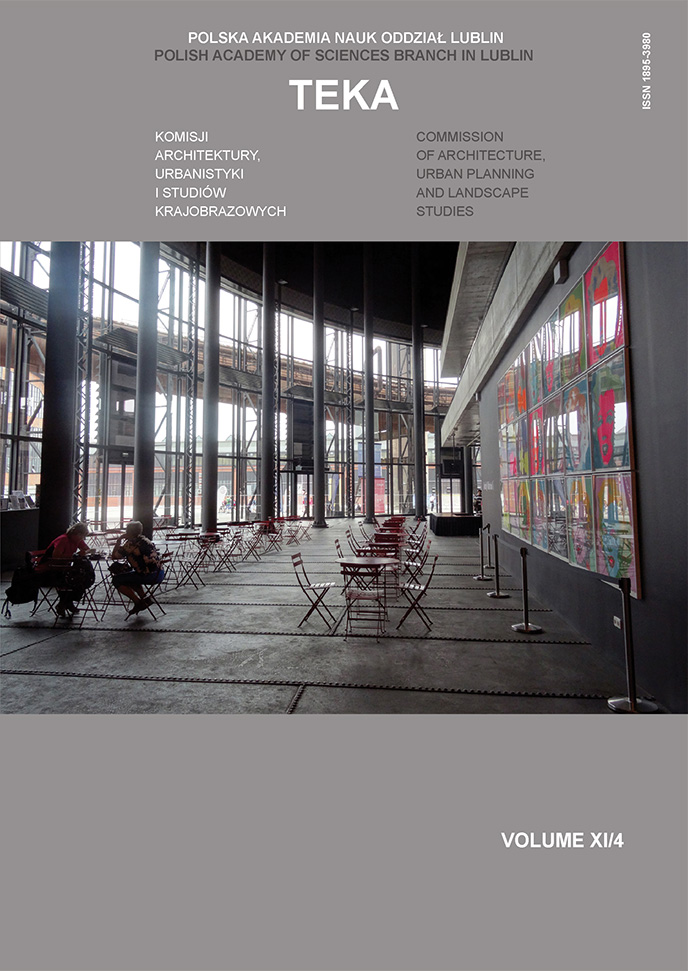Testing habitability for sustainable building design
##plugins.themes.bootstrap3.article.sidebar##
Open full text
Numer Tom 11 Nr 4 (2015)
-
Sposób postrzegania sacrum w architekturze współczesnej
Michał Dmitruk7-14
-
Mieszkalnictwo w dydaktyce
Agnieszka Kłopotowska, Maciej Kłopotowski15-23
-
Reklama w sztuce, sztuka w reklamie a przestrzeń publiczna
Agnieszka Chęć-Małyszek24-33
-
Fizyczna przestrzeń szkoły – współczesne kierunki projektowe
Wojciech Kocki, Jacek Bogucki, Bartłomiej Kwiatkowski34-41
-
Pokoje wyciszeń – współczesne tendencje projektowania
Bartłomiej Kwiatkowski42-48
-
Propozycja poprawy stanu energetycznego w osiedlu mieszkaniowym na podstawie oceny dotychczasowych termomodernizacji wielorodzinnych budynków prefabrykowanych
Anna Ostańska, Katarzyna Taracha49-59
-
Biblioteka sercem uczelni. Projekt biblioteki Phillips Exeter Academy, 1965−72
Marta Pieczara60-67
-
Placemaking według Louisa I. Kahna
Marta Pieczara68-77
-
Kompozycja architektoniczna w dydaktyce
Elżbieta Pytlarz78-86
-
Metody prowadzenia zajęć z przedmiotu projektowanie urbanistyczne ze studentami kierunku architektura na wydziale budownictwa i architektury Politechniki Lubelskiej
Marzena Joanna Siestrzewitowska87-99
-
O zagadnieniach relatywizmu w globalnej architekturze
Aleksander Serafin100-105
-
Cztery obiekty reprezentujące dwa kierunki spojrzenie na architekturę polską XXI wieku
Hubert Trammer106-116
-
Testing habitability for sustainable building design
Rolando-Arturo Cubillos-González117-125
-
Metody kreowania tymczasowych przestrzeni publicznych
Natalia Przesmycka126-143
Archiwum
-
Tom 15 Nr 4
2019-12-30 6
-
Tom 15 Nr 3
2019-10-31 9
-
Tom 15 Nr 2
2019-06-28 12
-
Tom 15 Nr 1
2019-03-29 13
-
Tom 14 Nr 3
2018-10-28 14
-
Tom 14 Nr 2
2018-06-29 14
-
Tom 14 Nr 1
2018-03-30 13
-
Tom 13 Nr 4
2017-12-29 8
-
Tom 13 Nr 3
2017-09-29 9
-
Tom 13 Nr 2
2017-06-30 10
-
Tom 13 Nr 1
2017-03-31 10
-
Tom 12 Nr 4
2016-12-30 12
-
Tom 12 Nr 3
2016-09-30 10
-
Tom 12 Nr 2
2016-06-30 9
-
Tom 12 Nr 1
2016-03-31 8
-
Tom 11 Nr 4
2015-12-30 14
-
Tom 11 Nr 3
2015-09-30 7
-
Tom 11 Nr 2
2015-06-30 8
-
Tom 11 Nr 1
2015-03-31 11
##plugins.themes.bootstrap3.article.main##
DOI
Authors
Abstrakt
This paper studied the concept of the habitability of buildings as a sustainability factor in the living environment, particularly in the city of Bogotá. The habitability factor stems from the relationship between human beings, the cultural dimension and the environment. Thus, we can say that the habitability factor is an important element in the building design process. Currently in Bogotá there are buildings that do not meet the requirements of the population. In Bogotá only 40% of buildings are of a good quality and a great number of newly produced buildings have made for lower quality living spaces. Consequently, it is important to give an adequate response to these kinds of demands. For thase reasons, this study created a model to evaluate the habitability factor of buildings. This model gives some guidelines for designing sustainable buildings and implementing stategies to design a better urban habitat. Finally, the Habitability model was tested as a pilot in the Primero de Mayo neighbourhood, which is located in the fourth district of Bogotá. The neighbourhood was classified as a cultural heritage site by city hall.
Słowa kluczowe:
Bibliografia
Arévalo, D. (2014). Implementación del sistema de certificación LEED en Colombia (pp. 17−17). Bogotá.
Brundtland, G. H. (1987). Our common future. General Assembly (pp. 400). New York: United Nations.
Calsa-Tres, M., Arcas-Abella, J., Cuchi, A., & Altés-Arlandis, A. (2009). HABITABILITY, THE SCALE OF SUSTANINABILITY. DIVA, 409−414.
Cubillos González, R. A. (2006). Vivienda social y flexibilidad en Bogotá. Bitacora Urbano Territorial, 10(1), 124−135.
Cubillos González, R. A. (2010). Sistema de gestión de información de proyectos de vivienda social (SGIPVIS). Revista de Arquitectura, 12, 90−101.
Edwards, B. (2005). Rough guide to sustainability. London: RIBA Enterprises Ltd.
Escallón-Gartner, C., & Villate-Matiz, C. (2013). Código de construcción para Bogotá: evaluación y propuesta de actualización en el marco de la sostenibilidad. Cuadernos de Vivienda y Urbanismo, 6(12), 248−259.
Kannamma, D., & Meenatchi, S. (2014). Design Best Practice Methods To Minimize the Impact of Building Materials on Urban Microclimate.
Mahdavi, a. (1998). Steps to a general theory of habitability. Human Ecology Review, 5(1), 23−30.
Ozuna, A., & Rivera, J. (2012). Sustainable Construction in Colombia: Main Actors and Implementation. IRBNet, 1−11.
Secretaría-de-Planeación-Distrital. (2015). DOCUMENTO EJECUTIVO POLÍTICA PÚBLICA DE ECOURBANISMOY CONSTRUCCIÓN SOSTENIBLE DE BOGOTÁ. Bogotá: Alcaldía Mayor de Bogotá.
Sikdar, S. K. (2003). Sustainable development and sustainability metrics. AIChE Journal, 49(8), 1928−1932. doi: 10.1002/aic.690490802. DOI: https://doi.org/10.1002/aic.690490802
##plugins.themes.bootstrap3.article.details##
Abstract views: 378


